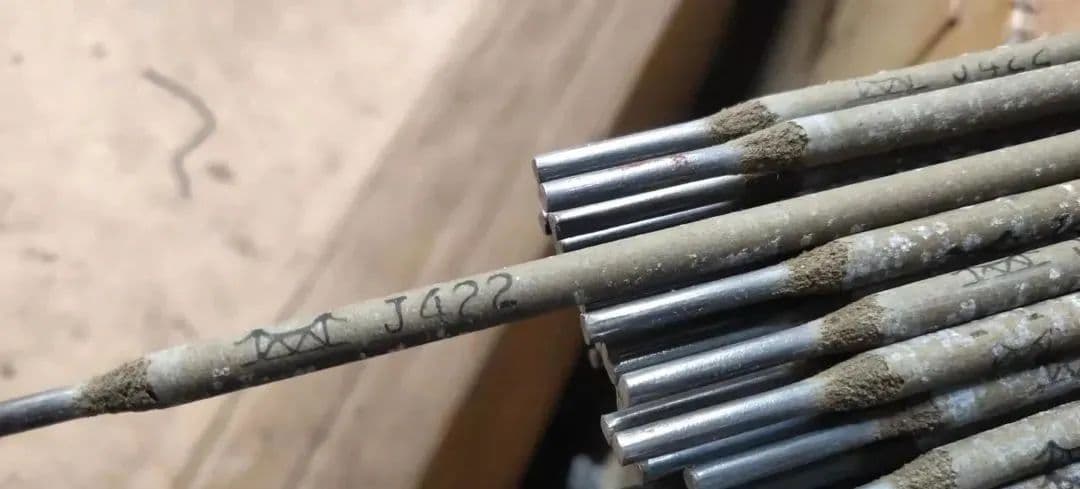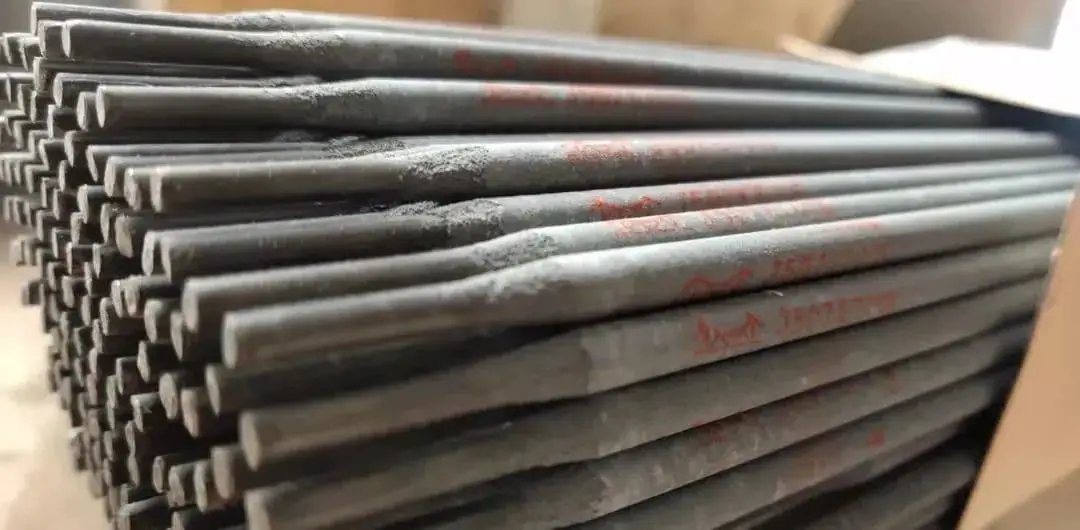Welding Rod
The most common electrodes are J422 and J507, where J422 is an acidic electrode and J507 is an alkaline electrode.
Based on the alkalinity classification of the slag produced after welding, welding electrodes can be divided into acidic electrodes and alkaline electrodes.
Related Reading: How to Choose the Right Welding Rod?
How to distinguish acid electrode from alkaline electrode faster?
The grade of the welding rod can reveal whether the welding rod is being used with a DC or AC welding machine. In addition, the grade of the welding rod can also indicate whether the welding rod is acidic or alkaline.

The J422 series of welding rods includes J421, J422, J423, J424, J425, J426 and J427. The J507 series of welding rods includes J501, J502, J503, J504, J505, J506 and J507. All are part of the carbon steel welding rod series.
To understand the specific meaning of a welding rod class, look at the last digit of the class. The last digit indicates the specific meaning.
| Last digit of welding rod grade | Type of coating | Current type |
| 0 | The type of coating is not specified | The applicable current type has not been specified |
| 1 | Titanium Oxide Coating | AC, DC |
| two | Titanium-calcium coating | AC, DC |
| 3 | Ilmenite type coating | AC, DC |
| 4 | Iron oxide type coating | AC, DC |
| 5 | High cellulose coating | AC, DC |
| 6 | Low Hydrogen and Potassium Type Drug Skin | AC, DC |
| 7 | Low Sodium Hydrogen Type Drug Skin | ADC |
| 8 | Graphite coating | AC, DC |
| 9 | Base coat | CC |
The third digit of the note also indicates the type of electrode coating. Electrodes with a large amount of acidic oxides (such as TiO2 and SiO2) in their coating are called acidic electrodes.
These include electrodes with titanium oxide type coating, titanium-calcium type coating, ilmenite type coating, iron oxide type coating and high cellulose type coating. These are acid electrodes, indicated by the third digit numbers 1, 2, 3, 4 and 5. They can be used with both AC and DC welding machines.
Acid electrodes offer good performance in the welding process, with a stable arc and minimal spatter, as well as good slag fluidity and easy slag removal, providing a beautiful weld appearance.
However, due to the high presence of silicate, iron oxide, titanium oxide, etc. In the coating, oxidation is strong, but the mechanical properties of the weld, particularly its impact resistance, are poor. Therefore, it is more suitable for welding low-carbon structural steels and low-alloy, low-strength structural steels. It is the most commonly used type of electrode.

Alkaline electrodes have a large amount of alkaline oxides (such as CaO and Na 2 O) in their coating. They rely on the decomposition of CO2 from carbonates (such as CaCO3 in marble) as a shielding gas, and the combination of CaF2 in fluorite with H to synthesize hydrogen fluoride (HF) at high temperatures, which reduces the hydrogen content in the solder. Thus, alkaline electrodes are also known as low hydrogen electrodes.

Electrodes with low hydrogen-potassium (J506) and low hydrogen-sodium (J507) coatings are classified as alkaline electrodes and are rated 5 and 6 in terms of electrode quality.
The J506 coating contains an arc stabilizer, which makes it easier to start an arc and maintain a stable arc during welding. This allows the J506 electrode to be used for AC and DC welding, while the J507 electrode can only be used for DC welding with reverse polarity.
Comparison of the characteristics of acid electrode and alkaline electrode:
- The components of the acidic electrode coating have strong oxidizing properties, while the components of the alkaline electrode coating have weak oxidizing properties.
- Acidic electrodes are not sensitive to porosity caused by water and rust and should be baked at temperatures between 75-150℃ for 1 hour before use. On the other hand, alkaline electrodes are sensitive to porosity caused by water and rust and should be baked at temperatures between 350-400℃ for 1-2 hours before use.
- The arc of acid electrodes is stable and can be used for both AC and DC welding. However, alkaline electrodes, which contain fluorine in their coating that deteriorates the stability of the arc, must be welded with direct current. Only when an arc stabilizer is added to the coating can the electrode be used for AC and DC welding.
- The welding current of acid electrodes is high, while the welding current of alkaline electrodes is about 10% lower than that of acid electrodes with the same specifications.
- Acidic electrodes must be operated with a long arc, while alkaline electrodes must be operated with a short arc to avoid the formation of porosity.
- The transition effect of alloying elements in acidic electrodes is weak, while the alkaline electrode has a good transition effect of alloying elements.
- Welds produced by acid electrodes are well formed and have shallow penetration, while welds produced by alkaline electrodes are well formed, easy to construct and have slightly deeper penetration.
- The slag structure of acidic electrodes is glassy, while the slag structure of alkaline electrodes is crystalline.
- It is easy to remove slag from acid electrode welds, but the first layer in the groove of alkaline electrode welds is difficult to remove, while the subsequent layers are easy to remove.
- The impact performance of acid electrode welds at normal and low temperatures is generally low, while the impact performance of alkaline electrode welds at normal and low temperatures is high.
- Acid electrodes have low crack resistance, while alkaline electrodes have good crack resistance.
- The hydrogen content in welds produced by acid electrodes is high and can easily lead to the formation of “white spots” and affect plasticity, while the hydrogen content in welds produced by alkaline electrodes is low.
- There is less smoke and dust during acid electrode welding, while there is more smoke and dust during alkaline electrode welding.
Comparison Table of Differences Between Acidic Electrode and Alkaline Electrode
| Category | Acid electrode | Alkaline electrode |
| Typical note | Exx03 | Exx15 |
| type | Titanium calcium type | Low hydrogen type |
| Power supply | AC/DC dual purpose | DC reverse connection |
| electric arc | Good stability | Poor stability |
| slag | Good liquidity | Good liquidity |
| Deslagging | easily | Poor |
| splash | any less | more |
| Appearance molding | good | hard |
| Weld bead | Moderate penetration | High weld bead |
| Toxic gas | any less | many |
| Sensitivity to impurities | low | high |
| Groove cleaning requirements | low | high |
| stoma | any less | Easy to produce |
| Hydrogen content | More | any less |
| Oxide inclusion | many | any less |
| desulfurization capacity | difference | strong |
| Mechanical properties of metals | Poor | good |
| Crack resistance | Poor | good |
| Slag state during welding | A layer of black and white mucus about 2 to 3 mm higher than the cast iron | A layer of dark red mucus about 1 mm thick, which is not stirred much and soon solidifies |
| Cast iron state during welding | Floating constantly | Relatively calm |
| Best condition | Make the molten slag cover about 2/3 of the molten pool | Make the molten slag cover the molten pool about 2/5 |
| Description of welding status | Flotation indicates that the gas in the cast iron can be fully discharged | Not calm means the welding rod is not dry or there is too much dirt on the surface or the arc is too long |
| Transitional form | Large falling transition or short circuit transition | Fine particle transition |

























































